For luxury that’s worth the wait

- Share via
A couple of eggs can save the day. When you’re at a loss over what to make, just crack, beat, scramble and you’ve got a meal pronto.
But hold on a minute.
In fact, hold on a few minutes.
If you slow things down a bit, you can turn scrambled eggs into something spectacular: Cooked very slowly, and stirred constantly, scrambled eggs can be a dish that’s creamy, rich and luxurious enough to serve as a first course at an elegant dinner.
Try it once, and you may never do the quick scramble again. Try it twice, and you’ll never fret again about a brunch menu.
The trick to the magical transformation of the slow scramble is simple enough: Lower the fire and stir with a patient hand.
Just remember that a beaten egg behaves differently at different temperatures. Cook it over high heat and the egg’s protein bonds seize up and tighten quickly, squeezing out the moisture as the egg cooks. You’ll end up with large, tough curds.
But switch to gentler heat and the protein bonds stay more relaxed as the egg cooks. You get divinely tender curds; the constant stirring keeps them tiny.
Be sure to use the best and freshest eggs possible. Look for them at farmers markets, if you can; sometimes stalls will even have araucanas (they’re the ones with blue-green shells) -- their flavor is extraordinary. At supermarkets, buy organic ones.
The eggs can be at room temperature or straight from the fridge, but cold eggs will mean a slower slow-scramble. (Slow-scrambled eggs take at least 10 minutes and up to 25 minutes, depending on the temperature of the eggs, the pan and even your kitchen.)
To get started, break a few eggs into a bowl, season with salt and pepper, and add a little bit of fat (such as butter, oil or creme fraiche). Whisk the mixture to blend completely.
Then place butter or oil in a nonstick skillet over low heat. Once the butter has melted, the pan is ready for the eggs. Pour them in, making sure the heat is at the lowest possible setting. Immediately begin stirring; you’ll be doing this constantly, with just a few pauses, varying your strokes to prevent large curds from forming.
In the first few minutes, it might seem as if not much is happening. But the eggs are actually thickening slowly. Curds will soon begin to form; they should be small, like cottage cheese curds. A few large ones may develop but will break up as you continue stirring.
Once you have a panful of curds that are still just a little glossy, take the eggs off the heat so they don’t overcook. Continue to stir for a minute or so. The eggs will lose a little more of their shine, but should still be moist and creamy when you serve them.
TURN DOWN THE HEAT
The most important thing throughout is to avoid overheating. Judy Rodgers, author of “The Zuni Cafe Cookbook,” likes to add cold butter bit by bit as she’s stirring the eggs. Butter adds richness, of course, but Rodgers points out that it “keeps the eggs from getting too hot and makes it homogenous and creamy.”
Rodgers also grates into the eggs a little bottarga (dried tuna roe that has been salted and pressed) and rubs her wooden spoon with garlic, infusing flavor as she stirs.
You could also match the luxury of slow-scrambled eggs with another luxury: truffles. Cookbook author Paula Wolfert adds a diced black truffle and a splash of cream to the eggs before cooking.
“I find that the way to get really moist and creamy scrambled eggs is to prepare them in a double boiler or in an earthen bowl set over simmering water,” says Wolfert. “The double boiler is narrow so there is less of a chance of creating a lot of curds,” making the eggs creamier.
Keep the water in the bottom chamber at a low simmer, and don’t let it boil. If you find the pan is overheating, though, you can do one of two things: Add a drop of water or cream to the eggs while you’re stirring, or lift the pot away from the simmering water to cool things down a bit, Wolfert says.
And don’t be shy about stirring, she adds. Run the wooden spoon around the edges, move it in circles, do figure eights; you don’t want to miss any spots and end up with large clumps.
She tops each serving with a thin slice of black truffle for her oeufs brouilles aux truffes (truffled scrambled eggs).
But even with simpler accompaniments, slow-scrambled eggs are fabulous. Spread the eggs on toasted slices of rustic bread, for example, and top with a slice of prosciutto.
Or add fresh herbs, as chef David Lentz does for his Tweety scramble at Hungry Cat in Hollywood. Lentz stirs in creme fraiche and Jack cheese to his slow-scrambled eggs, then balances the richness with chives, Italian parsley and chervil. He tops the eggs with a salad made with more herbs and a little lemon vinaigrette.
The beauty of slow-scrambled eggs is that you don’t need fancy ingredients to make a luxurious dish. And once you’ve made them part of your repertoire, eggs won’t just save the day. They’ll make your day.
More to Read
Eat your way across L.A.
Get our weekly Tasting Notes newsletter for reviews, news and more.
You may occasionally receive promotional content from the Los Angeles Times.









